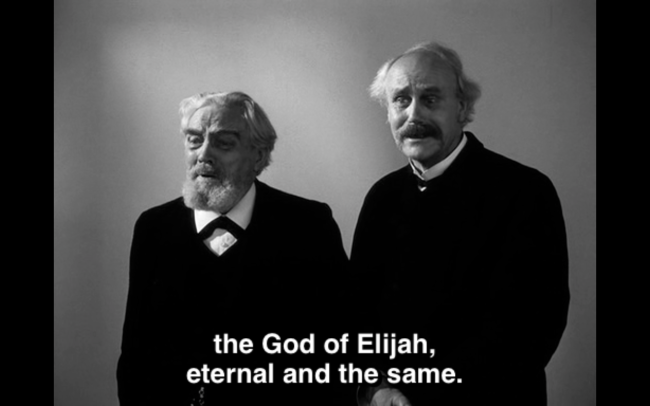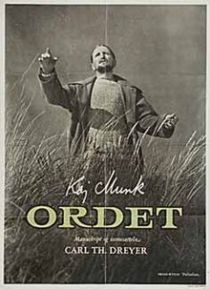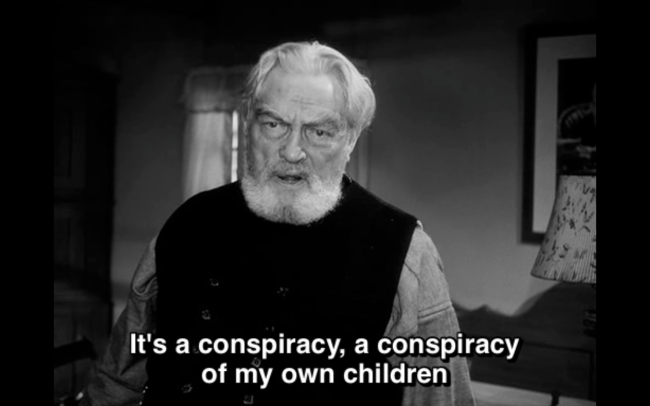Ordet – Carl Th. Dreyer, 1955
Character’s Role (taken from http://en.wikipedia.org/wiki/Ordet) :
<<Morten – patriarch of the family, prominent member of the community, and patron of the local parish church, father of three sons.
Mikkel – the eldest son who has no faith, but is happily married to the pious Inger, who is pregnant with their third child.
Johannes – the second son who went insane studying Søren Kierkegaard, believes himself to be Jesus Christ and wanders the farm condemning the age’s lack of faith, including that of his family and the modern-minded new pastor of the village.
Anders – the youngest son who fell in love with lovesick for Anne Petersen, the daughter of Peter the Tailor, leader of a local Christian religious sect ( different sect from Morten)>>
One of Carl Dreyer’s most acclaimed works, Ordet is a tale of many characters – each having a struggle of love and faith. The themes are obvious; the characters constantly talk about their faith, or the lack of it. Dreyer tackles the daunting theme remarkably; the tussle between different sects of Christianity was resolved with the resurrection of Inger, where both men proclaimed that they both have the same God, even if they believed in different outcomes of death, and Inger’s husband Mikkel, proclaims that he has finally found faith when Inger arises from her eternal slumber.
Ordet is not a “plot” film. It’s an intense and turbulent poem with several motifs constantly in action, ultimately to be harmonized by Inger’s resurrection.
Set in a farm at rural Denmark, Dreyer paid outmost attention to the historical accuracy, especially towards set decoration. Dryer made his crew equip the set with what they thought was appropriate for a country kitchen and removed the excess props until he was satisfied.
The actress, Federspiel, said that Dreyer had personally picked out costumes for every actor and even went to the extent of buying her stockings with her. Federspiel was really pregnant during filming, even her birth cries were real – Dreyer tape recorded them and used it in the film to make the scene authentic.
Like what David Thomson states in The New Biographical Dictionary of Film, Dreyer’s “ films are devoted principally to human emotions, and if they seem relatively subdued, then that may be a proper reason for calling in Danishness. But simplicity and purity of style do not argue against intensity, Dreyer’s greatness is in the way that he makes a tranquil picture of overwhelming feelings. His art, and his intelligence, make passion orderly without ever cheating on it.” True to that, there is little done for dramatic effect in Ordet, the tone of the footage remains constant, moody and atmospheric throughout, without the usage of any light meters, evident of Dreyer’s mastery over light and shadow.
Careful compositions, monochromic photography and long takes marked Dreyer’s signature style of film. One scene in Ordet typically only had one take, if not three. The smoothness of the pans and zooms of the camera add to the slow pace of the film, allowing us to feel the fullness of such a country life, The distinctive resonance of the sound, the pauses filled with action and reaction of the actors, pull us further into the quiet, peaceful countryside setting of the film, as though we were in the house, with big empty walls resonating the voices of the characters.
There was very sparse usage of any close-ups, indicating that Dreyer wanted the audience not to relate to the characters, but to ponder upon their actions and judge for ourselves, whether we would do the same in that situation. Dreyer wanted to “distance” or to “alienate” his audience from the characters and the action and render them observers who would not become involved in or to sympathize emotionally with the characters. The audience would understand the characters’ dilemmas and the wrongdoings producing these dilemmas. Thus, the audience could be able to reach an intellectual level of understanding, while being alienated emotionally from the characters, they would be empowered to analyze and judge the situation for themselves.
By putting us from a bystander’s point of view, Dreyer enables us to see the reality within the world of the film, and thereby uses the distancing effect (V-effekt).
Would we have been able to identify a messiah now, though we can easily identify Jesus in biblical text? Is it better to believe every savior that comes along, or shun away all prophets of faith, including the real one that comes along? Like Jesus had found fault in the faith of his followers, Johannes criticizes the faith of his family members. In spite of being Johannes being branded a lunatic, there seemed to be insight and prophecy in his ravings. Was it a coincidence that Johannes carried the same name as John the messenger (Johannes being the Hebrew version of John) or was it to show the devotion of Morten to God?
Ordet was the only film by Dreyer to be both a critical and financial success, as well as being acclaimed as one of the most spiritually significant films of all time by the Arts and Faith online community. Some parts of the film, especially scenes with Johanne’s preachings may make us uncomfortable, just like how some parts of the Bible render uneasiness. Yet, it calls on us to have faith and pray for what we want, something we tend to forget in the hustle for faith, we forget to ask.
Dreyer does not seek to document reality, but to capture the ephemeral essence of its underlying truth.
Dreyer has since influenced many other prominent filmmakers such as Jean-Luc Godard, Alfred Hitchcock, and Pier Paolo Pasolini, just to name a few. Ordet has been edited into two projects for Jean-Luc Godard, Origins of The 21st Century and Notre Musique.
References:
1. Acquarello. 2002. Senses of Cinema – Carl Theodor Dreyer. [online] Available at: http://sensesofcinema.com/2002/great-directors/dreyer/ [Accessed: 23 Jun 2013].
2. Decentfilms.com. 1920. Ordet (1955). [online] Available at: http://decentfilms.com/reviews/ordet [Accessed: 23 Jun 2013].
3. En.wikipedia.org. 1955. Ordet – Wikipedia, the free encyclopedia. [online] Available at: http://en.wikipedia.org/wiki/Ordet [Accessed: 23 Jun 2013].
4. En.wikipedia.org. 2007. Distancing effect – Wikipedia, the free encyclopedia. [online] Available at: https://en.wikipedia.org/wiki/Distancing_effect [Accessed: 23 Jun 2013].
5. IMDb. 1955. Ordet (1955). [online] Available at: http://www.imdb.com/title/tt0048452/?ref_=ttmc_mc_tt [Accessed: 23 Jun 2013].
6. The Criterion Collection. 1960. Carl Th. Dreyer. [online] Available at: http://www.criterion.com/current/posts/226-carl-th-dreyer [Accessed: 20 Jun 2013].
7. The Criterion Collection. 1944. Ordet. [online] Available at: http://www.criterion.com/current/posts/128-ordet [Accessed: 20 Jun 2013].
8. the Guardian. 2012. Ordet – review. [online] Available at: http://www.guardian.co.uk/film/2012/mar/08/ordet-film-review [Accessed: 20 Jun 2013].
9. Theyshootpictures.com. 2007. TSPDT – Carl Theodor Dreyer. [online] Available at: http://www.theyshootpictures.com/dreyercarl.htm [Accessed: 23 Jun 2013].
Bernice Lam is an aspiring writer-film maker, chorale trained singer, web comic enthusiast, and amateur twitterer. You can see her state of the art shenanigans at twitter.com/be_dramarie


Whatsuppp Bernice ^^
WHAT A GREAT CRITICAL RESPONSE FROM YOU!
Your response for ordet was insightful and reflective especially for paragraph 7, where you mentioned that Dreyer wants the audience to be emotionally detached from the characters so that they can BE the one justifying the situation instead of sympathizing AT the situation.
i believe you have fulfilled all the cultural, historical especially Dreyer’s aesthetical significance in this film.
i’ve added the characters’ roles and the meaning of “ordet” in order to benefit those who have yet to watch this film 🙂
Yay thanks!